


Few sights are guaranteed to bring a smile to someone's face as much as a big plate of cupcakes. No cutting. No portioning. No hassle. Just grab, peel and eat. Quick and easy to make, these tiny treasures are universally appreciated. More forgiving than full sized cakes, they nonetheless present a few unique challenges. This page is dedicated to making them easier, more reliable and better tasting. I hope you enjoy it.
Follow these simple hints and you'll soon be making the best cupcakes ever. (For those preferring to watch this page as a video, please scoll to the bottom of the page for a link to its YouTube version.)
Trick 1: Warm Liquid Ingredients
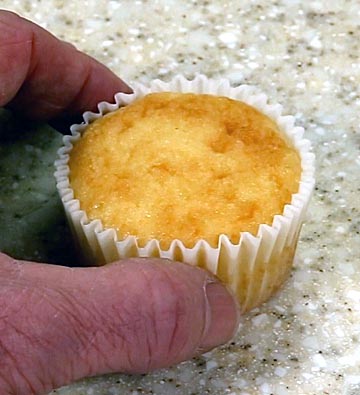
Because cupcakes have a high ratio of surface area to volume, they tend to dry out quickly in the oven. Even worse, if cold liquids, which I recommend farther down the page, are used the batter goes into the oven cold. This means the cupcakes will take longer to bake and that the outsides will be over baked in order for the centers to be done.
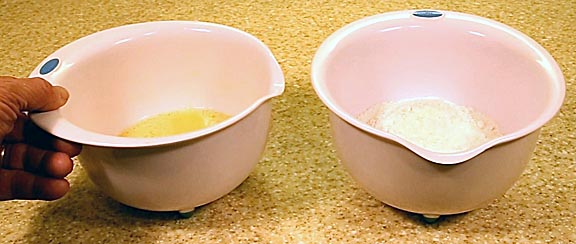
To avoid this, measure out all your dry and liquid ingredients in separate bowls. Whisk the wet ingredients to mix, then warm them in a microwave for 30 seconds to a minute to 120 - 140 degrees. Whisk again then mix them into the dry ingredients. Now the batter will be warm and the cupcakes will bake more evenly. An added benefit is that they will also bake faster, typically in only 11 minutes instead of 15 to 20. Shorter baking times mean moister cupcakes.
And speaking of mixing...
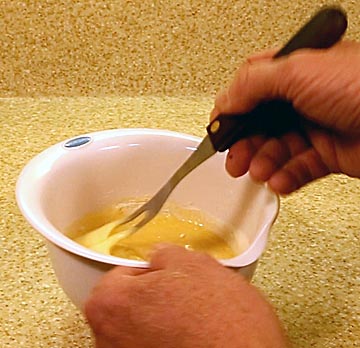
I prefer using a two-pronged fork to blend the wet and dry ingredients until they are just mixed. This avoids beating excess air into the batter that tends to make the cakes too light and fluffy. Because they are usually eaten out of hand instead of with a fork, cupcakes do better if they are slightly denser than regular cakes.
Trick
2: Accurate Scooping
Scooping inconsistent amounts of batter into cupcake papers invariably results in uneven results, such as in the following image:
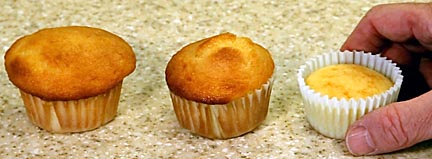
From right to left:
The wimpy cupcake resulting from too little batter,
The volcano cupcake with a hard-to-decorate peak
and worst of all - The muffin-topped cupcake with overdone edges.
Accurate scooping is the key to avoiding these disasters. But there's a problem: every batter rises differently. The solution is to know your batters and use the correct tools.
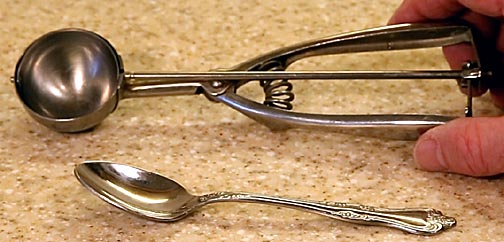
Two indispensable tools are a 1 and 7/8 inch diameter ice cream scoop and a dinner spoon. The spoon is used to accurately remove the proper amount of batter from the scoop so that the remainder is the perfect amount for optimum rising. For example, my chocolate cupcake batter rises more than any other. A level scoop will rise enough to flow over the top of the papers. To avoid this I scoop up batter, then use the spoon's smallest curved edge, near the handle, and scrape it across the scoop twice. This removes 1/3 of the batter and leaves an ideal amount. Before dispensing the batter into a cupcake paper, I also use the spoon to scrape any dripping batter of the bottom of the scoop so that it doesn't drop onto the cupcake sheet. For my vanilla and spice cupcakes a single scrape with the middle edge of the spoon works well. My lemon cupcakes, which start rising immediately because of the added lemon juice, need to be scooped to overflowing because they don't rise very much in the oven.
The repeated use of "My" when referring to these recipes was not an expression of ego, but to emphasize that these amounts only work for the recipes I use. Yours may rise differently so experimentation will be necessary to produce the desired results. This work is worth it because it provides the knowledge needed to make perfectly uniform cupcakes like the following:
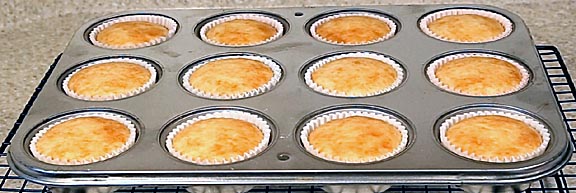
Trick 3: Cool Cupcakes Covered
Steam boiling off fresh-from-the-oven cupcakes may look attractive, but it's a moistness killer. The more it's reduced the moister the cupcakes will be. One way to do this is to cover the cupcakes with another cupcake sheet and use large binder clips to secure the four sides to the bottom cupcake sheet.
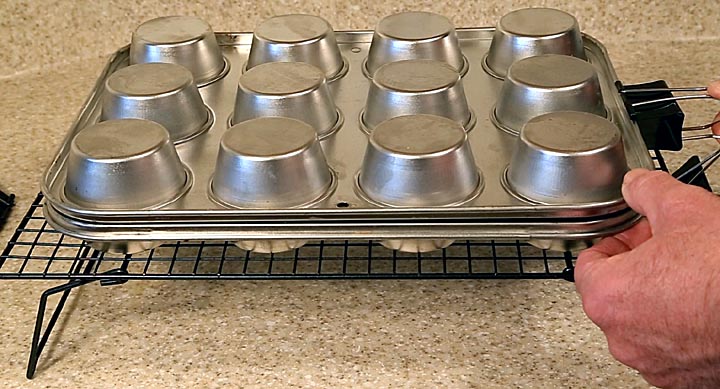
Cooled like this the cupcakes retain most of their moister.
Trick 4: Use Box Mixes
Right now if you're a strictly bake-from-scratch baker you're probably thinking I've gone mad. But please read on. I've been baking cakes for 40 years, most from scratch, and I've discovered some box mixes deserve more respect than they are given.
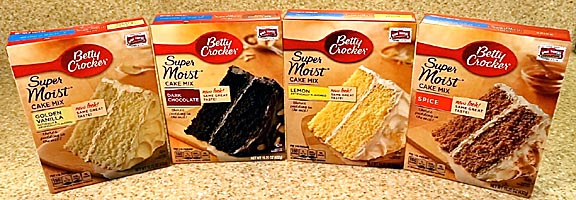
Why start with cake mixes? Because the accuracy and consistency of their premeasured ingredients is greater than what most home bakers can achieve. Starting with a boxed mix removes most of the stumbling blocks that ruin many made-from-scratch cakes. Take flour. Depending on how it's scooped a cup can weight anywhere from 120 to 180 grams, one makes a cake that's too wet, the other too dry and tough. Mixes also contain compounds such as emulsifiers that aren't available to home chefs. These chemicals improve consistency, make mixing easier and improving the texture of the cake. They also automatically adjust for minor variations in how the batter is mixed to provide greater reliability in the end cake.
In other words: they're idiot proof.
Many bakers fault boxed mixes for having poor flavor. In many cases they're right, but I've found this is most often the fault of a manufacturer producing a bad formula, not a fault with the concept of a boxed mix. If you've tried a box mix and were disappointed in the results, the fault might not be with the fact that the cake came out of a box, but rather that it was the wrong box. The key is to test various brands and select the one that tastes the best to you. The four in the image above are my favorites, with the exception of the dark chocolate mix. Pillsbury's dark chocolate cake is much better and I used it to rave reviews for years. But in late 2014 it was discontinued. Betty Crocker's isn't as good, but with doctoring it's still better than what I can make from scratch.
My own experience is that if I select the best tasting box mix available and make a few minor changes to the wet ingredients mixed into it the result is a cake that is more consistent, better tasting and has a better texture than any made-from-scratch cake I've made.
The trick is to modify some of the ingredients to improve the final result. For the vanilla and chocolate mixes I use whole milk instead of water and squeeze Parkay margarine instead of oil. (Note: Squeeze Parkay doesn't taste very good by itself, but for some reason it makes cakes taste better than even using real butter.) The chocolate cake by itself tastes too harsh. Adding half a cup of sugar creates a better balance. For the lemon cake, replacing a half cup water with half a cup of lemon juice really brightens its flavor. However, using milk and Parkay makes it heartier, which weakens the zesty lemon flavor such cupcakes should have. The same also applies to spice cupcakes.
For detailed reviews of cake mixes and doctoring experiments, please see my CAKE page.
Bonus Trick #1: Cupcake Paper Keepers
One of my pet peeves is sprung cupcake liners.

I like paper liners to drop right to the bottom of the cupcake form. To ensure that they do so, I cut 2-inch high stripes of card stock, wrap them around a rolling pin and tape them together to form short tubes. Bunches of ten cupcake liners go into each one, compressing them so they remain tight enough so that when they are removed they fit into cupcake sheets without hanging in midair like the one in the image above.
Bonus Trick #2: Bake the Right Types of Cupcakes
You're making several dozen cupcakes for an event. How many should be chocolate, vanilla, lemon... etc? For several years I used large family parties and functions at work to see which varieties went the fastest. Chocolate with vanilla frosting was most favored, vanishing twice as fast as any of the others. Second was chocolate with chocolate frosting. Lemon with lemon frosting and spice with cream cheese frosting tied for third. Vanilla cupcakes with vanilla frosting came in last, though still appreciated by everyone who tried them.

One of the trays of cupcakes used for taste testing at work.
Based on these results, for every ten people I recommend four chocolate cupcakes with vanilla frosting, three chocolate with chocolate frosting, two lemon, two spice and one vanilla. That leaves two extra so no one feels guilty about taking the last cupcake.
I sincerely
hope you enjoyed this page. The following video presents this page in
live action format:
Return to my main page to browse 60 other subjects